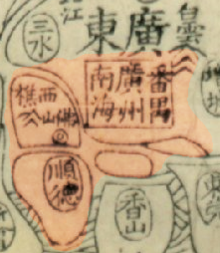| Sanyi | |||||||||||||
|---|---|---|---|---|---|---|---|---|---|---|---|---|---|
 Detail of a 1797 map, with added highlighting on the Guangzhou area, including the Sanyi[1] | |||||||||||||
| Chinese | 三邑 | ||||||||||||
| Literal meaning | Three counties | ||||||||||||
| |||||||||||||
| Alternative Chinese name | |||||||||||||
| Traditional Chinese | 南番順 | ||||||||||||
| Simplified Chinese | 南番顺 | ||||||||||||
| Literal meaning | Nanhai Panyu Shunde | ||||||||||||
| |||||||||||||
Sanyi (Chinese: 三邑; pinyin: sānyì; Jyutping: sam1 jap1; lit. 'Three counties') or Nanpanshun (Chinese: 南番順; pinyin: Nánpānshùn; Jyutping: naam4 pun1 seon6; lit. 'Nanhai Panyu Shunde'), also known by Cantonese romanizations such as Sam Yup and Nam Pun Shun, refers to the three districts (former counties) of Nanhai, Panyu and Shunde surrounding Guangzhou and Foshan in Guangdong, China.
YouTube Encyclopedic
-
1/2Views:3 5563 950
-
Maganin ciwon sanyi na mata da wanda maza suke dauka wajen jima'i
-
Illar Sanyi ga maza
Transcription
Geography
The former counties and the corresponding modern districts are
- Nanhai
- Modern Nanhai and Chancheng in Foshan and a small part of Liwan in Guangzhou
- Panyu
- Modern Panyu, Yuexiu, large part of Liwan, Haizhu, Huangpu, Baiyun and large part of Nansha, all in Guangzhou
- Shunde
- Modern Shunde, Foshan
Dialects
The area gave rise to the Yuehai dialects, the most prominent of which is Cantonese (Guangzhou/Guangfu dialect). Standard Cantonese is based on the Yuehai dialects belongs to the Yue branch of Chinese, Cantonese speakers easily understand throughout Chinese part of Lingnan area.
Emigration

Most of the Chinese immigrants to the United States in the late 19th century and early 20th century came from eight districts in the Pearl River Delta, including the three districts of Sanyi, together with the four districts of Siyi to the southwest[2][3] and the district of Zhongshan.[4]: 19
See also
References
- ^ Jing ban tian wen quan tu, by Ma Junliang, 1797. (Library of Congress)
- ^ Lai, Him Mark (2004). "The Sanyi (Sam Yup) community in America". On Becoming Chinese American: A History of Communities and Institutions. Rowman Altamira. pp. 77–142. ISBN 978-0-759-10458-7.
- ^ Tan, Chee-Beng, ed. (2007). Chinese Transnational Networks. Taylor & Francis. ISBN 978-0-415-39583-0.
- ^ Peter Kwong and Dusanka Miscevic (2005). Chinese America: the untold story of America's oldest new community. The New Press. ISBN 978-1-56584-962-4.
